At the Southern Border, an Escape Room With No Exit
The more one sees of its widespread dysfunction, the less sense it makes.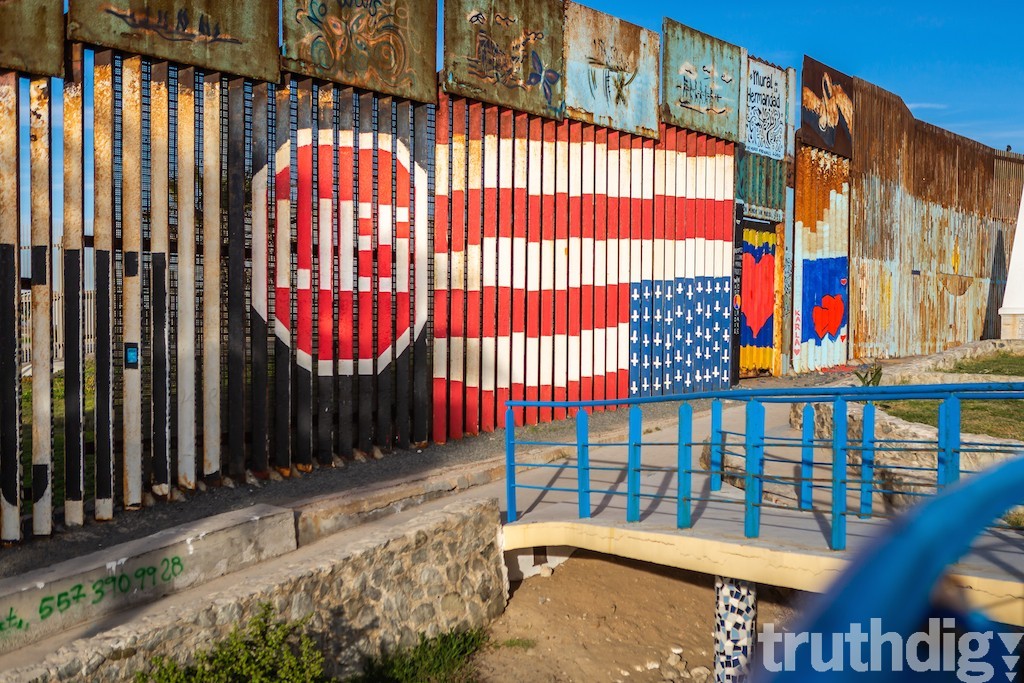 Michael Nigro / Truthdig
Michael Nigro / Truthdig
In December and again in January, I went to Tijuana, at the U.S.-Mexico border, to report on what is happening to the thousands of men, women and children living in an appalling limbo as they seek asylum in the United States.
In Tijuana, there are the refugees themselves, who come from such far-flung countries as Yemen, Ethiopia, Haiti, El Salvador and Honduras, and who live in camps all over the city, places that bloom with hope and wither in despair, camps that exist one day and then vanish the next.
This backdrop of humanity supports a bewildering array of refugee ecosystems. There are well-meaning volunteer organizations, and there are impenetrable state-run services. There is an underground network of “coyotes” to help refugees jump border fences, and there are aloof, nongovernmental organization workers with infuriating savior complexes. There are local, state and federal law enforcement agencies that create on-the-spot rules that contradict the directive given the day prior, and there are anti-immigrant groups within Mexico itself. There is aggressive suppression of journalists, and there is infighting among migrant factions.
The best analogy for Tijuana is that it’s the most absurd, open-air escape room ever devised, except that the asylum-seekers can’t exactly “tap out” or quit when they’ve had enough.
Here is what I witnessed and documented. It’s an incomplete picture of the border, to be sure, but the more one sees of its widespread dysfunction, the less sense it makes.
Unaccompanied
Am I in the right place?
That is my first thought when the cab driver pulls over and points emphatically at the meter—a universal sign for “Pay me.”
I check the GPS app on my phone. It says zona norte, considered by many to be Tijuana’s most dangerous neighborhood. Zooming in on the screen, I see I am where I’m supposed to be: the Benito Juárez sports stadium, where a few weeks ago, the Mexican government bottlenecked nearly 6,000 Central American asylum-seekers.
But where was everyone?
I am aware that many immigrants have been moved to other camps, but this street is empty. And it looks nothing like what I have seen on the news: an overcrowded tent city filled with desperate, homeless men, women and children.
A municipal police car is on the other side of the concrete barriers in front of the stadium, but residual rain-filth indicates that the vehicle hasn’t been moved in weeks.
Perhaps it had been abandoned? Am I even in the right place? Is there something wrong with my GPS?
“Benito Juárez?“ I ask the cab driver, my inflection going up to convey my confusion, because I am unsure if I should get out.
The cab driver points again, down the empty street, where, about 300 yards away, I spot a few colorful tarps and pitched tents. Beyond them, I can just make out the silver-lettering of a sign: Benito Juárez.
“Ah, OK, thanks,” I say.
His finger snaps back to the meter. Pay me.
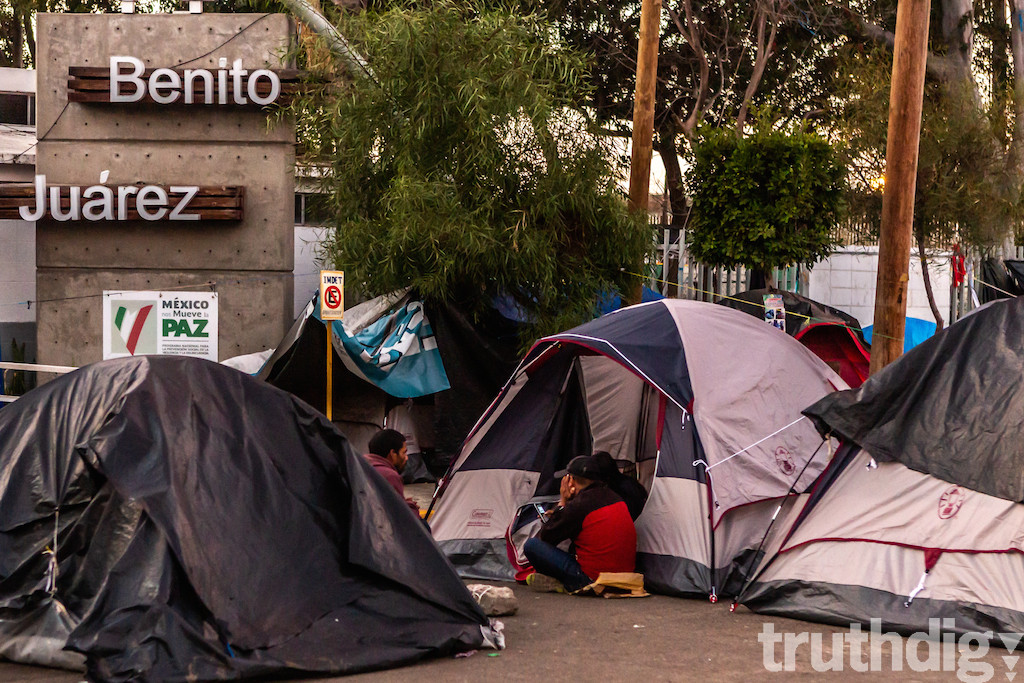
The First Three Hours
Halfway down the street, tucked behind a row of buildings, people are congregating outside a warehouse. Some are eating from flimsy containers, drinking from Styrofoam cups. An interview is being conducted by a three-person documentary crew, a row of port-o-johns as their backdrop. (I find out later that the port-o-johns are a big deal. Before they were brought in, there was no place for the migrants to go to the bathroom.)
The entrance to the warehouse is a metal security gate, on a loading dock big enough for a truck to fit. The door is partially raised, and inside, dinner is being distributed to hundreds of migrants.
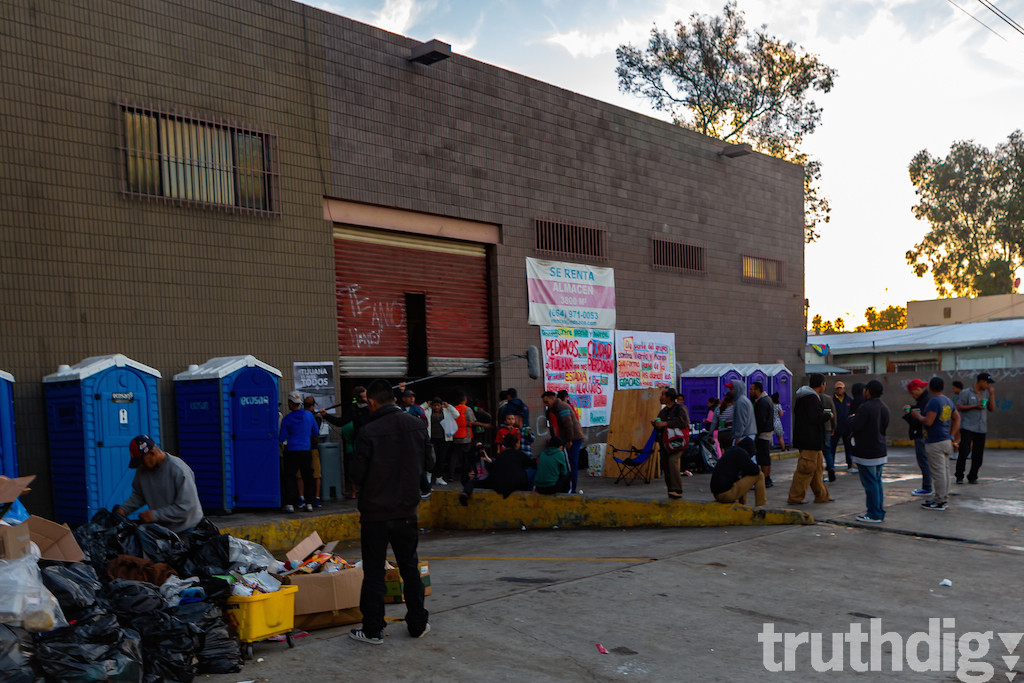
The building—which was opened after heavy rains flooded the original outdoor encampment—has little electricity and no heat, but it is dry.
Inside, food distribution is orderly and controlled. The main light source comes from broken windows that run along the second floor of the warehouse. But the golden-hour daylight angling through the windows looks more like ribbons of old Super 8 film, grainy with dust and depressing particles of who-knows-what. Some inside wear masks. Most do not.
A man wearing an orange safety vest asks me to leave. I assume he’s functioning as a security guard, or maybe just someone making sure everything stays orderly.
I find out from the camera operator of the documentary crew that around 750 people have set up their tents inside the multilevel building, and approximately another 350 people have decided to stay camped out in the streets, in their tents.
“Where are the other 5,000 people?” I ask.
“Ha! All over,” he tells me. “It’s hard to keep track. It’s like whack-a-mole here. You never know how long shelters stay open.”
Later, I listen to an aid worker from Tijuana. I don’t catch her name, but she’s around 25 and distraught. Other journalists and activists seem to know her and have gathered to hear what she’s saying.
Earlier, horrific news sent a wave of sadness and panic throughout the asylum-seeker camps. Two unaccompanied minors from Honduras, who had gone missing on Dec. 15, 2018, were found strangled and stabbed to death. A third boy managed to escape. They had been lured from their encampment, held for ransom money, of which none came (because none existed), and were then tortured.
U.S. Customs and Border Protection (CBP) has taken to turning away unaccompanied minors, who were once allowed to apply immediately for asylum in the United States on humanitarian grounds.
The boys who were killed were Jasson Ricardo and Jorge Alexander.
They were 16 and 17.
I have been in Tijuana for less than three hours when I hear the news.
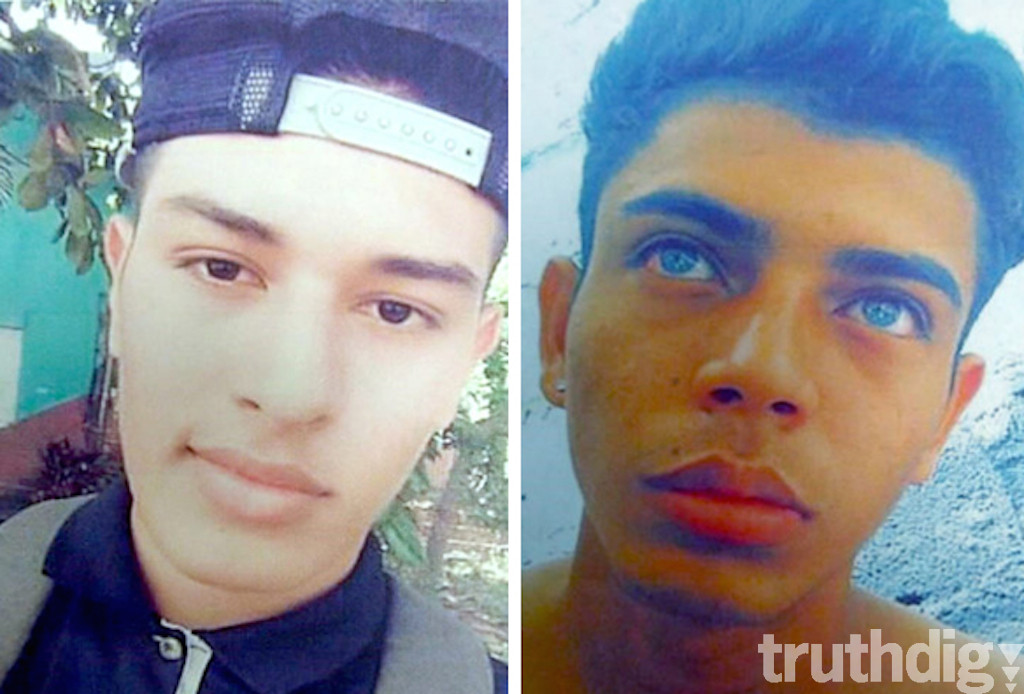
Step Into the Milk
From a distance, the scene looks normal, even quaint: A young couple out for an evening walk, pushing their little boy in a stroller. The boy, perhaps 18 months old, is singing and happy and rhythmically bobbing back and forth, like he’s at the front row of a heavy-metal concert.
The parents shrug and smile at each other and then, as they come closer, notice I’m in on the moment, too. My Spanish is terrible, but we don’t need to speak to know what, I believe, we are collectively thinking: They live in a tent on the street, have little food, water, clothing or medical supplies, are surrounded by gangs, the police harass them, their stroller is a jalopy, the nights are getting colder, applying for asylum is a bureaucratic mountain. How, then, is it possible that their son at this moment is really, really happy?
And he’s making us laugh. A lot.
We Spanglish at each other. They are from Honduras, have been living in the streets for weeks and have no idea when they’ll be able to file for asylum.
The man, noticing my cameras, asks if I’m a journalist.
Sometimes, when I’m on assignment, my cameras feel like protection. At other times, they are a bull’s-eye. Occasionally, they grant me access. Often, I hide my emotion and bias behind them. But the worst is when my cameras feel like an albatross.
In situations like this, I am acutely aware that the camera equipment hinged to my body is probably worth more than anything these people have ever owned, and I’m embarrassed.
I’m not sure what to say, so I ask if can take their picture.
The dad is happy about that and puts his arms around his family. But I don’t take the shot; I want them to move into better light. “Let’s move,” I say. “En la leche … en la leche.”
This confuses them, of course, because what I told them was to “move into the milk.” I quickly correct myself and point to the light just behind them.
“La luz,” I say, “The light. No leche. No leche. Soy estúpido!”
We laugh, but I’m aware of the woman’s disappointment, her posture deflating as she speaks to the husband. I’m not sure what she’s saying exactly, but it’s all about milk. “Leche, leche,” she keeps saying.
Another photographer, who has witnessed the exchange (and is rightfully laughing at me), translates. For a moment, the mom thought I was going to give them milk, something they haven’t been able to get for their son in weeks.
I don’t make them ask. I give them 100 pesos (about $5, which in Tijuana will buy a couple of weeks worth of milk).
They are thankful, and the dad points to the camera, “Photo?”
Without moving into better light, I take a shot of a family who is, at least for that moment, happy.
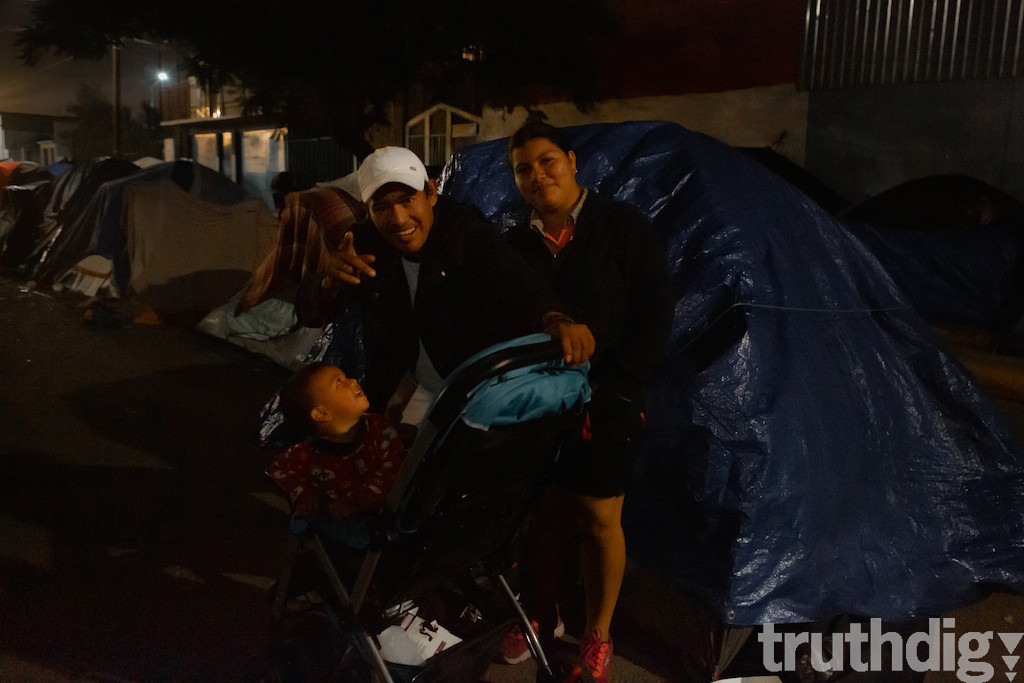
Stumbling on a Drug Deal
The rust-colored border fence begins whipping by like slats of a zoetrope. Our Uber ride is finally moving at a highway pace. It’s just before 3 p.m., and cars have been clotting the eastbound highway along the U.S.-Mexico border, making what should have been a 20-minute ride last over an hour.
Cellphone service is spotty, so it’s been impossible to reach Rodrigo and Tucker, two American activists who have agreed to show us a section of the border wall where immigrants are known to jump the fence.
I’m sharing a ride with two other activists who have brought their organizing and empathy to Tijuana. I’m in the back seat with Kei, who has been in Tijuana for weeks. She’s in her 20s, originally from New Jersey, and I have noticed that she is a welcome sight to many immigrants.
Sitting next to our no-nonsense Uber driver is Doug. Doug has spent the past two days changing in and out of a makeshift Santa costume, delivering early Christmas gifts (bathroom necessities and candy) to families and children living in the main refugee camps.
Doug has been slowly prepping our driver for a destination change, asking if he would please drop us off at a specific spot on the side of the highway.
“I can show exactly where it is,” Doug says. “There’s a pull-off area, and I promise you we’re just going to hop out.”
The driver is skeptical. He tells us how Uber drivers in Tijuana are often targets of gunpoint robberies, and that multiple stops can indicate setups. We’ve heard about this too, and, conversely, about how cabs have often been complicit in robberies or kidnappings.
Our dialogue is friendly, and once we come around the highway bend, where we need to be dropped off, the driver has an epiphany, “Oh, here! OK.”
He knows the spot and pulls off the highway onto a dirt apron, skidding slightly to a full stop. To the right, about 150 yards through rocky terrain and desert brush, is the border wall. There are also two people—“Rodrigo and Tucker,” Kei says—in the direct pathway of our stopped car, about 20 feet away.
Standing statue-still, both faces set in a terrified rictus, they remind me of two deer in the headlights. In a way, they look guilty.
“What are they doing?” Doug asks, as he waves at them through the windshield.
For the next few minutes, life feels like being in a blender set to “puree.”
Recognizing Doug, Rodrigo and Tucker begin running toward the car.
The Uber driver panics. He attempts to pull away, but the highway traffic is too fast and too thick, and Rodrigo is now in front of the car and Tucker is yanking on Kei’s locked door. “What are you doing?” Tucker screams through the window at us. Doug and I are telling the Uber driver, “These are our friends. They’re OK, Let them in!”
But the driver says, “No, they can’t get in. No.” And he tries to drive off again.
Rodrigo is speaking to the Uber driver in Spanish, but I’m can’t understand a word because everyone is speaking, yelling. English. Spanish. Swearing.
Tucker is now at my door, yanking on the handle and banging on the window.
Doug, at some point, calmly says, “We’ll tip you very well—very, very well.”
And then, I’m not sure whether it’s Rodrigo or Tucker, but one of them yells, “Open the fucking doors! We’re being chased by fucking drug runners!”
The car doors open.
Rodrigo and Tucker pour into the car like tsunamis of energy and fear and sweat, yelling, “Drive! Drive!”
There are now six of us in a four-person car, and the Uber driver, who is visibly rattled, pulls quickly onto the highway.
It is around 3 in the afternoon when this happens. According to Rodrigo and Tucker, they had walked right into an active drug transaction.
They tell us that they were approached by two men who said, “You shouldn’t be here” and “Get the fuck out of here.”
Rodrigo, who is fluent in Spanish, tried to explain that they are medics (not true) looking to see if anyone on the border needed medical attention.
But there was no further discussion, just menace.
Their about-face and double-time march back to the highway was met with walkie-talkies going off around them, and then, other people along the route began to chase them. They began to sprint toward the highway.
In an odd bit of timing, when they reached the dirt apron, the first thing they saw was our car pulling onto the berm and skidding to a stop.
“I thought you were cartel who had been radioed to come to kill us,” Tucker says.
“Yeah,” Rodrigo adds. “I saw the car and thought, ‘Well, this is where I die.’ ”
It has been widely reported that the vast percentage of drugs come through official ports of entry. But while I did not see any drugs being passed through the steel slats, locals tell me that smaller quantities of drugs are, in fact, passed through the border wall, even when CBP vehicles are within sight. Some claim—vehemently so—that these small dealings are accomplished with the aid of American contractors.
Later that night, Doug and I return to the same spot on the highway. There, we witness a number of immigrants moving along the border. Eventually, an asylum-seeker climbs over the wall, scales over ribbons of razor wire, drops down and then silently walks past American contractors fortifying the barriers, so she can turn herself into U.S. Customs and Border Protection.
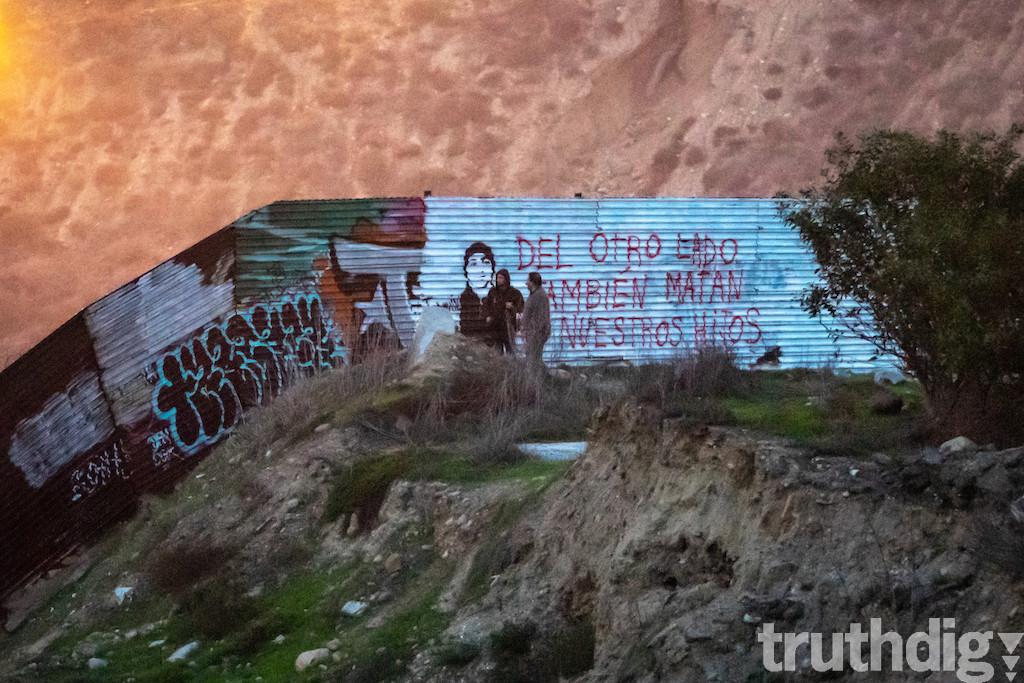
Numbers Game
Calling it a “lottery” is not quite right, but that is what many refer to the morning ritual at Garita El Chaparral, a public space at the border.
There’s a waiting list (a big gray book, actually) filled with thousands of names and numbers. Immigrants wanting to apply for asylum must add their name to this book to enter this opaque system. Once registered, they are assigned a number—their “ticket” to begin the preliminary asylum process. But the number has to be called out first. Each number, by the way, has 10 names associated with it.
So every morning, at around 7:30, someone begins to call out names and numbers from this book. In December, approximately 3,000 immigrants have put their name on the list.
The first time I attend this daily drama, I am told they are on number 1203. I’m observing from 20 feet away when a voice next to me says, “I feel like it’s the Great Depression, and we’re at a shipping dock where people are gathered, hoping to hear their name called so they can get a day of work.”
It’s a woman with long, white hair and an American accent. She’s in her early 60s and is staring hopelessly at the immigrants who are beginning to crowd around the tent.
That’s a more accurate description than “lottery,” I think. “Yeah, it does feel that way,” I say.
“Fuck that,” a man, perhaps 30, grunts at us. “This is more like ‘The Hunger Games.’ ”
And then he walks away, toward the tent where a woman holding a bullhorn begins reading from the thick ledger, calling out the names, numbers and countries of origin.
“Does that comparison work?” I ask the woman. “ ‘The Hunger Games’?”
“Sort of,” she says, still looking straight ahead, “All these people are fighting for their lives.”
“Are you with a particular group?” I ask.
Now she looks at me. “Are you a journalist?”
“Yes,” I say.
“Oh, I don’t speak to journalists.” And then she too walks toward the tent.
According to Jonathan Blitzer, a staff writer for The New Yorker who has been covering the refugee crisis, “The Department of Homeland Security “meters,” or limits, the number of people who can seek asylum in the U.S. on any given day, and Mexican authorities coöperate by controlling the flow on their side of the border. Neither government wants to acknowledge its involvement in the backlog, especially the Americans, and so they have outsourced the process of dealing with it to the immigrants themselves.”
This has given rise to rumors of corruption within the system itself. One accusation I hear of numerous times but can’t substantiate is that some immigrants are paying off those running the process in order to get a better number.
It seems plausible, certainly possible. But what are these people going to do? And who are they going to complain to?
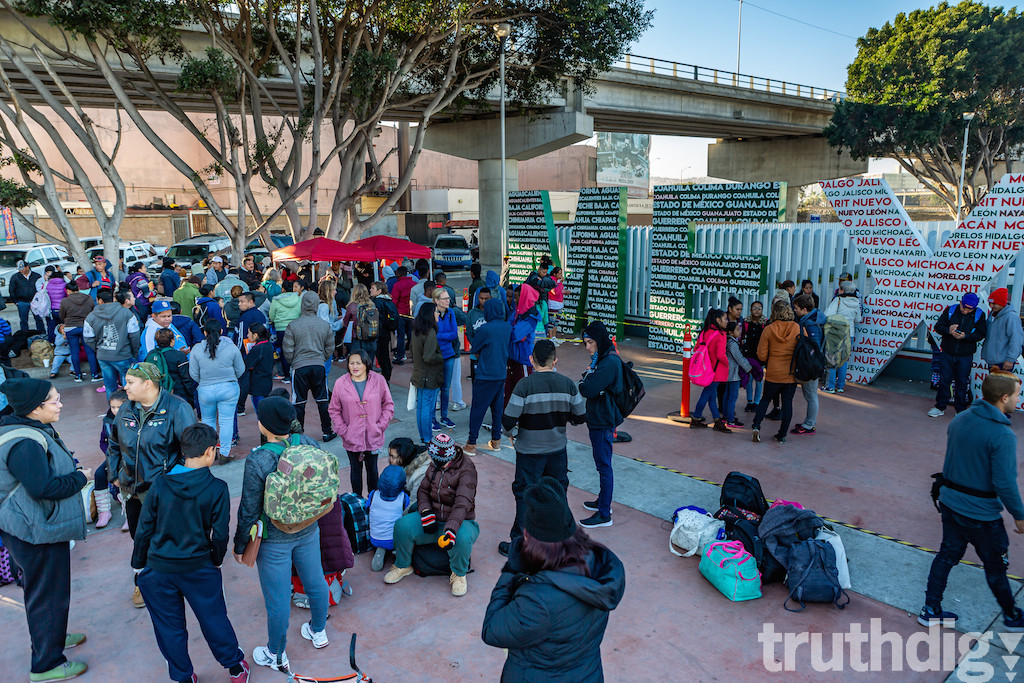
A Friendly Farewell
Weeks later, on my second trip to the border, not much has changed in how the lottery runs at El Chaparral. With so few cases being processed, I’m not surprised to recognize some of the same people I either met or noticed during my first visit.
One group is a coterie of young immigrant men, all in their 20s, who are hanging out together. I noticed them the first time because of their good nature, their positivity and, frankly, because they look a bit like a boy band. Plus, a documentary crew had been following them, but I now learn that the crew departed a few weeks back.
The group shows up this morning because one of their friends’ number has been called, and they are all there to support him. I don’t remember this particular immigrant from back in December, but I learn that he is a minor and that he has fled Honduras because of violence. I honor his friends’ request not to photograph his face or use his name.
His friends—immigrants and activists alike—stay with him as he waits for a bus that will transport him and the others whose numbers are called that day to San Diego. There, they will all file a “credible-fear claim,” beginning the process for asylum.
This, however, is the day after Donald Trump announces the Migrant Protection Protocols. Under this protocol, after the asylum-seekers make their claims, the U.S. government can send them back to Mexico to wait for their judicial review, a process that could take months, even years. Most have nowhere to stay in the meantime.
It is also possible that their friend will be placed in one of the U.S. detention centers, into what they refer to as a hielera, which translates to “icebox.” Effectively, it’s a prison, and on the surface, there seem to be some humanitarian issues with it. The temperature inside is 48 degrees Fahrenheit, and each detainee is allowed only one layer of clothing. It’s often so cramped one cannot lie down, and the food served to detainees is often unrecognizable. Detention is not to supposed to last more than 72 hours, but some detainees, I am told, have been held for up two months.
Before their friend boards the bus, he wants to change into his chosen single layer of clothing. For privacy, at his request, his friends raise jackets and shirts around him so he can change.
This might be the last bit of privacy he gets for quite some time.
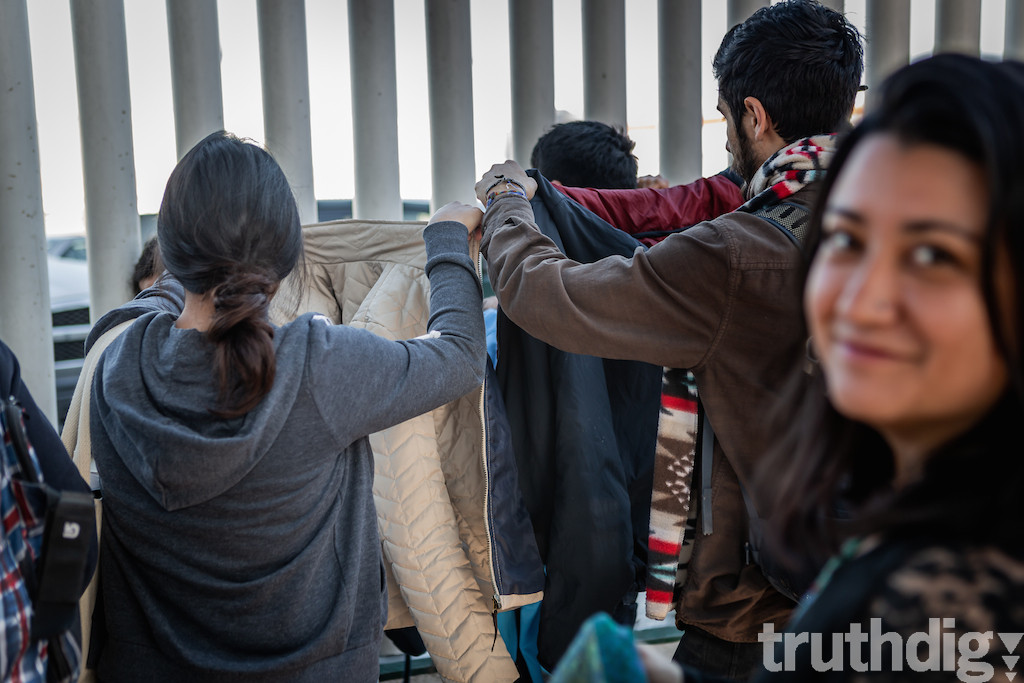
So Many Messiahs
A hand comes over my lens. It’s another border volunteer with a colossal savior complex, and he’s telling me that I cannot take photos.
I am shooting industrial-size black garbage bags that are filled with bread. Lunch is being served outside El Barretal, where there are approximately 2,700 immigrants.
This is the umpteenth time I’ve run into people policing journalists. It’s just not worth my time to discuss the First Amendment and the importance of documentation, so I turn to him, shrug and say, “No English.” He begins miming the act of taking a photo and says, “No, no, no.”
I pretend I don’t understand, turn back to the bread-filled bags and begin shooting again. I think he’s goes away.
But then, the second coming. It’s Jesus with an American apostle who speaks Spanish. She gives me a long spiel, which I assume is telling me to stop taking photographs. I shrug, and this time I say, “No Spanish.”
Jesus gives up.
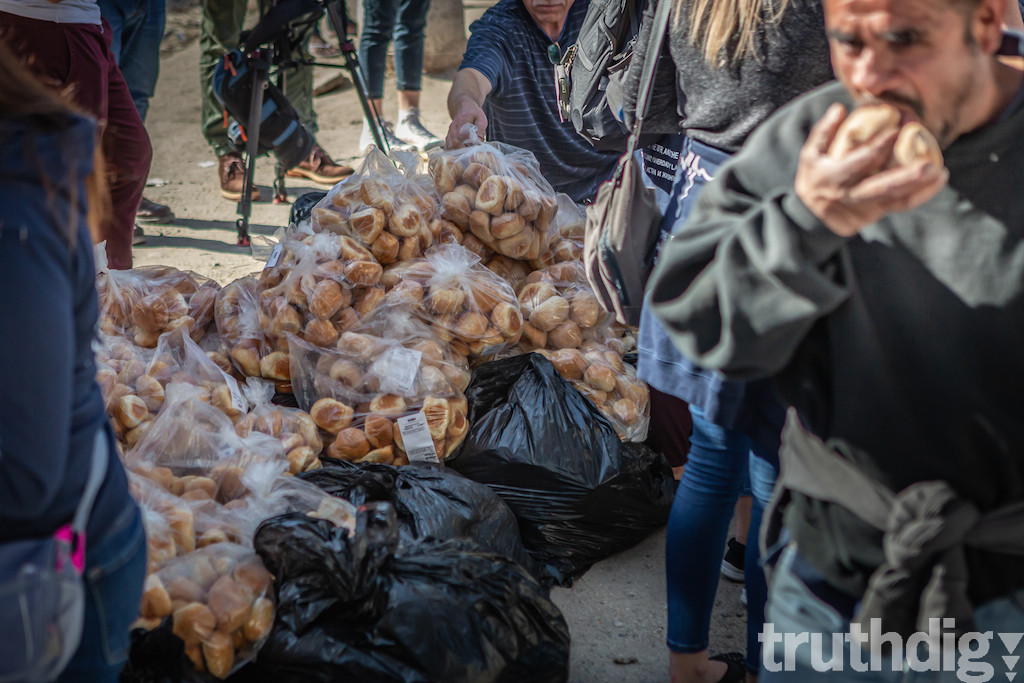
Presentable
The street lights in Tijuana cast a Trump-orange hue on everyone and everything. It feels like a cruel joke on the asylum-seekers. I never bring this up to anyone but wonder if I should fix everyone’s skin tone when I edit my photos. To do so would take away the Trumpian shadow cast upon these people, right?
Part of me thinks that’s a good thing. Another part of me doesn’t want to alter the reality of the environment. Besides, when livestreaming, there’s not much I can do about the coloring or, for that matter, the content I capture.
Salma is my translator tonight. She’s an activist who lives in Tijuana and has been working with migrants long before the so-called “caravan” arrived in November. I’ve been livestreaming from Benito Juárez for the past half-hour, and we find ourselves between the warehouse where some migrants are staying indoors and the dwindling street encampment.
These two groups are at odds. Both want a movement to arise from the migrant community in Mexico, a show of strength and solidarity, but factions have formed and people have to choose sides.
I am about to ask Salma about movements in general—are power struggles simply in the DNA of movement building?—when a head pops into my livestream frame.
Enter Mitchell. He’s just had a shower at a church down the road—it cost him 10 pesos—and he feels great. I take a few shots of him as he tells us that this is the first shower he’s had in quite a while. Tomorrow, he is sure, his number will be called at El Chaparral.
Mitchell left Honduras on Oct. 8. He walked 10 to 12 hours a day, averaging approximately 30 miles. He’s in his early 20s.
Later, off-camera, Mitchell tells me that he wants to “look good” when his number is called. He asks to see the photos I’ve taken of him. He’s disappointed. I’m sure it’s the orange-tinged light. I tell him that I’ll take another of him tomorrow at El Chaparral, and we agree to meet the next morning at the lottery.
Mitchel doesn’t show up, however. I am there at 7 a.m., so I don’t think I missed him. And as far as I can tell, only five numbers are called that day. The country of origin for those numbers were all Cameroon.
I return to El Chaparral every morning I’m in Tijuana to watch the lottery process and witness the cruel absurdity. Every day is different. The amount of numbers called seems random, and people are gathered not only from Central America but from a variety of countries—Haiti, Yemen and Ethiopia, to name a few.
Cameras are not welcome at the lottery, and unless I have an asylum-seeker’s express permission, I normally don’t shoot their faces. I often position myself away from the crowd, but on my last day there, I’m framing a group of activists holding a sign that says “ABOGADOS” (lawyers) when a head pops into my frame.
Mitchell. Same smile, same hat, same clothes.
I take a half dozen shots of him.
His number hasn’t been called yet, but through a translator, he tells me that today is the day. He’s sure of it.
“Is that true?” I ask the translator, who is also an activist working with Mitchell.
“We don’t know. His number is close, but we don’t really know.”
Mitchell wants to see the shots, He’s happy with these.
“Oh, yes,” He says. “Presentable.”
But his number is not called that day.
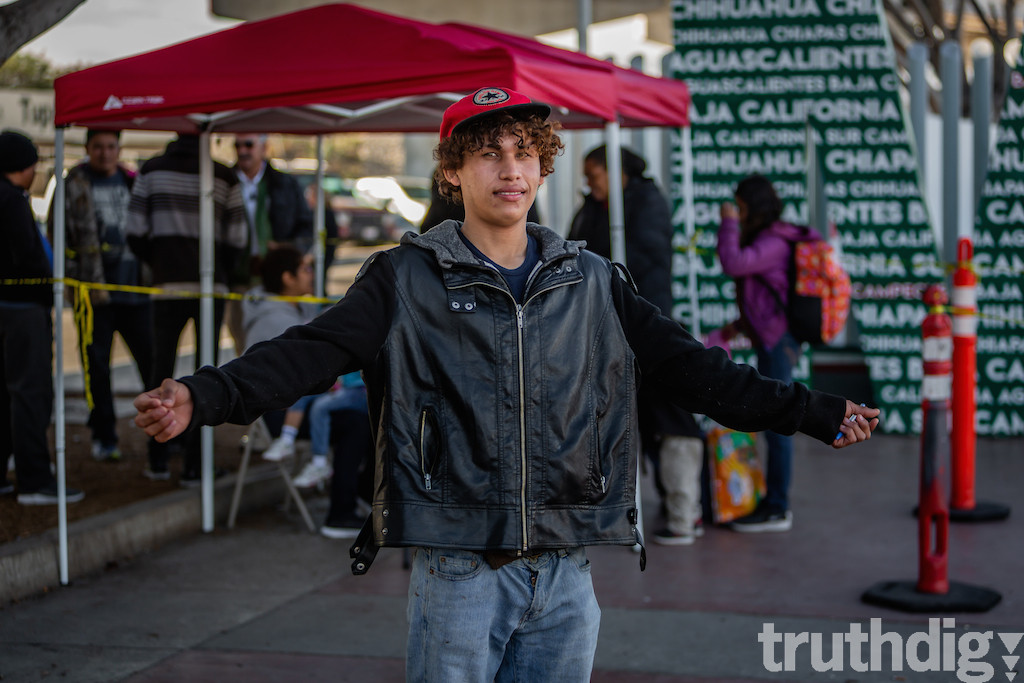
Family Arguments
It’s Christmas Day. I get a text from a friend I’ll call Andrew. He’s originally from Texas.
Andrew: Could you solve an argument for my family? What percentage of the “caravan” is adult male? My parents are Republicans.
Me: It’s very hard for me to give a percentage, as many of the children are in “secure” zones in camps. The camps are also dispersed with families procuring safe houses and spaces. I can’t really put a number on men versus women (plus kids), but it seems pretty even. Skewed perhaps to men, but men are just more visible—and that’s for safety reasons.
Andrew: But it’s not 95 percent men?
Me: No. Not even close. … These are families. Women. Children. It is a really complicated situation, but from what I’ve seen, it’s thousands of women and children, many who are hiding out. Again, the men are simply more visible because, perhaps, they feel less at risk.
Andrew: Okay. Thanks. Be safe down there, and Merry Christmas.
This, I am sure, solves nothing around his family dinner table. And for some reason, it bothers me that I don’t know what I could have written to him, what story I could have shared, to open his parents’ minds even the tiniest of bits.
A fact? Should I send him a fact? Sure, why not.
Me: Tell them that Social Security payroll taxes paid by undocumented workers, who can never claim those benefits, has led to a $463 billion funding surplus paying for the retirement of this country’s aging, mostly white, population.
I never press “send.”
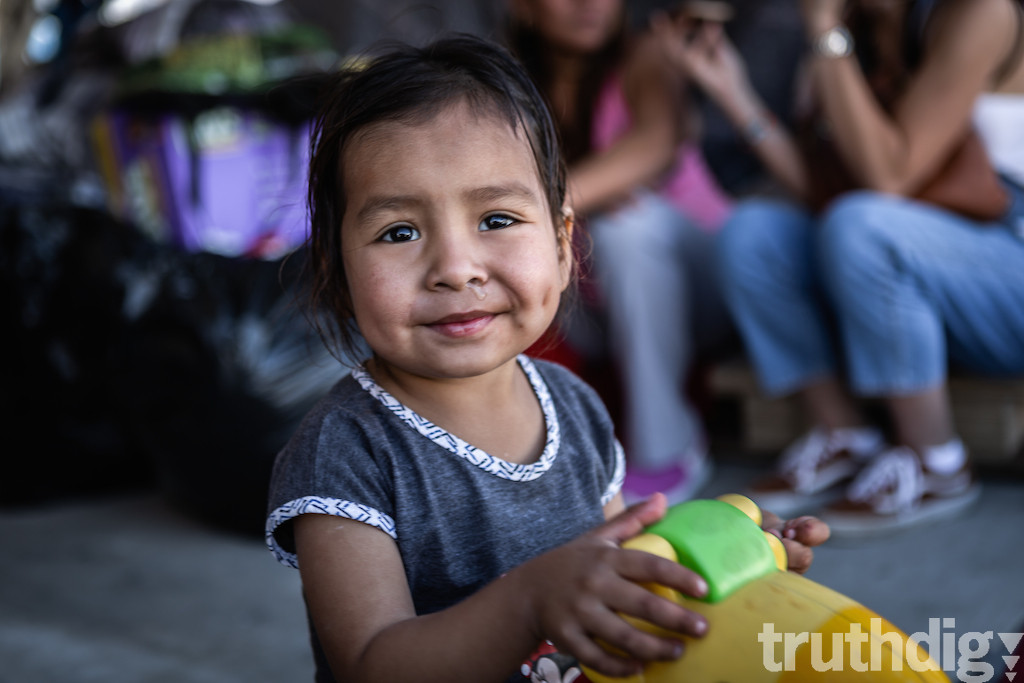
Black Bags
Manuel is 18 and tells me through an interpreter that he traveled alone from Honduras. He has some family members who stayed behind, but he also has family in the U.S. and in Spain. He would rather not discuss or give details, however. Like many immigrants in Tijuana, he is not comfortable revealing personal information for fear of gang reprisals.
Manuel and I met outside the makeshift Tijuana offices of Al Otro Lado (The Other Side), a binational border rights project that provides legal orientation and know-your-rights training to asylum seekers. He agrees to let me come along with him and an activist with a car to retrieve his belongings from El Barretal, another encampment about 10 miles south of Tijuana. El Barretal is a defunct outdoor nightclub, a space where concerts and sporting events used to be held.
When I first went to El Barretal in December, nearly 2,500 asylum seekers were living there. The arena was surrounded by armed military and a variety of law enforcement agencies.
Who was in charge? Anyone with a gun. Or a badge. Or both. That’s what it felt like back in December. And it feels no different this time. We pull up and park just outside the main entrance, still gated and guarded.
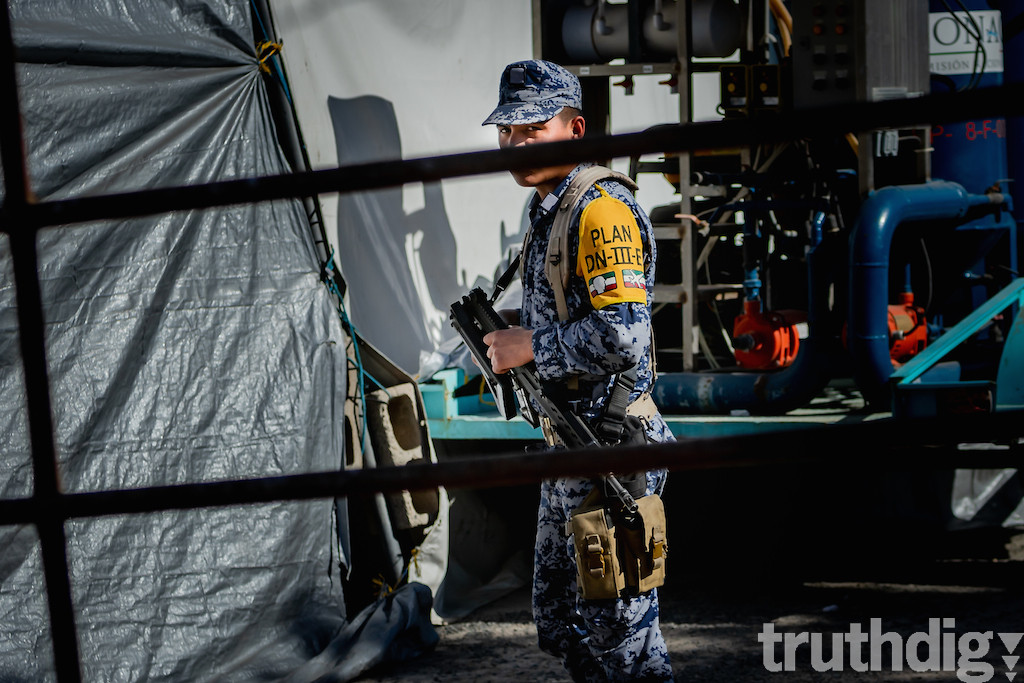
Dangling around Manuel’s neck is a photo ID—a plastic card furnished to every refugee processed here. He has flashed it to the armed guards and been allowed to enter.
As a journalist, I can only gain entry with official credentials, between the hours of 11 a.m. and 1 p.m. In December, the first time I entered the gatekeepers took my press pass and the letter from my editor. They threatened to keep the ID and/or not allow me back in if I did not leave the premises on time.
The very next day, I returned to El Barretal, and the very same people decided that my press ID wasn’t good enough and asked for my passport, which they also kept until I exited. Once, they held me and other journalists outside the gates until 12:15 for no particular reason.
“Leave by 1,” some official said when we were finally allowed entry.
For days, Manuel tells us, there have been rumors that the camp at El Barretal is going to be raided and everyone will be evicted. No one seems to know where any of the refugees will be taken, and Manuel, who believes his number is getting close to being called in the morning lottery, doesn’t want to be taken too far away from the border.
This is one of the reasons many of the Central American migrants didn’t want to leave the original camp at Benito Juárez. “We could see the border,” a woman from Honduras told me. “After such a long journey, I didn’t want to move away from it.”
More troubling for Manuel is that others in El Barretal have been experiencing harassment by law enforcement. Tales are rampant of police putting immigrants into vehicles, driving them away from camp and threatening them with immediate deportation if they don’t hand over all their money.
This was not the first time I have heard this. Or the second. Or the fifth. Many refugees living in the camps have procured day jobs in Tijuana, with government buses providing transportation for them. But those who get off the bus at the end of the day, I have been told, become easy targets for corrupt officers.
Manuel doesn’t have much, but he also didn’t want to risk being moved further from Tijuana and put at further risk. A network of activists has been working tirelessly to procure safe spaces for as many at-risk immigrants as possible. Manuel is lucky to have found a group willing to help him.
Inside El Barretal, Manuel packs up his belongings and says his goodbyes.
I explore what is left of the encampment. Perhaps 300 people remain. Most, I am told, have been taken to various shelters scattered across Tijuana. Some jumped the fence and turned themselves into Customs and Border Protection. Hundreds agreed to be taken back to Honduras, an offer from the Mexican government. Others, who knows?
In December, when there were approximately 2,500 people living there, it’s not an exaggeration to say that most everyone was plagued with some sort of ailment—respiratory problems, skin rashes, lice, limps or dental issues. There were four cases of chicken pox, and people were being screened for influenza and tuberculosis. Gone now are the medical tents, the large nongovernmental organizations, the children’s play area and the safe spaces for women escaping domestic violence.
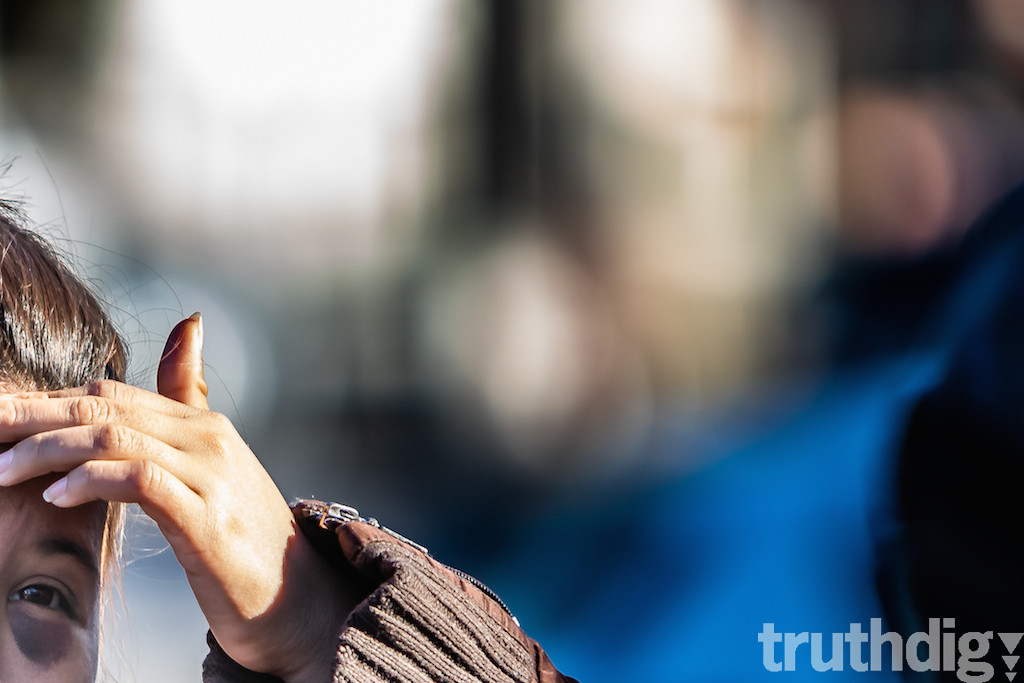
Before I can find out if meals are still being served twice a day, I am told I need to go to the front office because someone saw me taking too many pictures. This is bad; it is possible that they are going to make me erase some, if not all, of my photos.
I quickly jam my main camera into my backpack but hold on to my cellphone and a second camera that I have not yet used that day.
When I walk into the sign-in/sign-out area, a guard is holding my press ID and begins asking me questions. Who am I with? What news organizations do I work for? Why was I taking pictures of the families in the tents?
A woman I assumed to be the journalist liaison for El Barretal, someone I have dealt with numerous times before, enters and demands that I erase my photos.
That isn’t going to happen.
I don’t say anything. I simply turn on the camera I haven’t used yet. Show her exactly zero images.
She’s not buying it, but she hands my ID back to me and says, “You are not allowed to come here anymore. You are banned from entering.”
As I walk out of the office with my cameras—and my photos—Manuel is also exiting, but from the main gate. He is carrying an industrial-size black garbage bag filled with everything he owns. I wonder if the bag he’s carrying is one that was previously filled with bread rolls.
Carrying our black bags, we are both leaving El Barretal for the last time.
Two days later, on Jan. 29, everyone at El Barretal is evicted.
For the people who there at the time of the eviction, there is no set place for them to go.
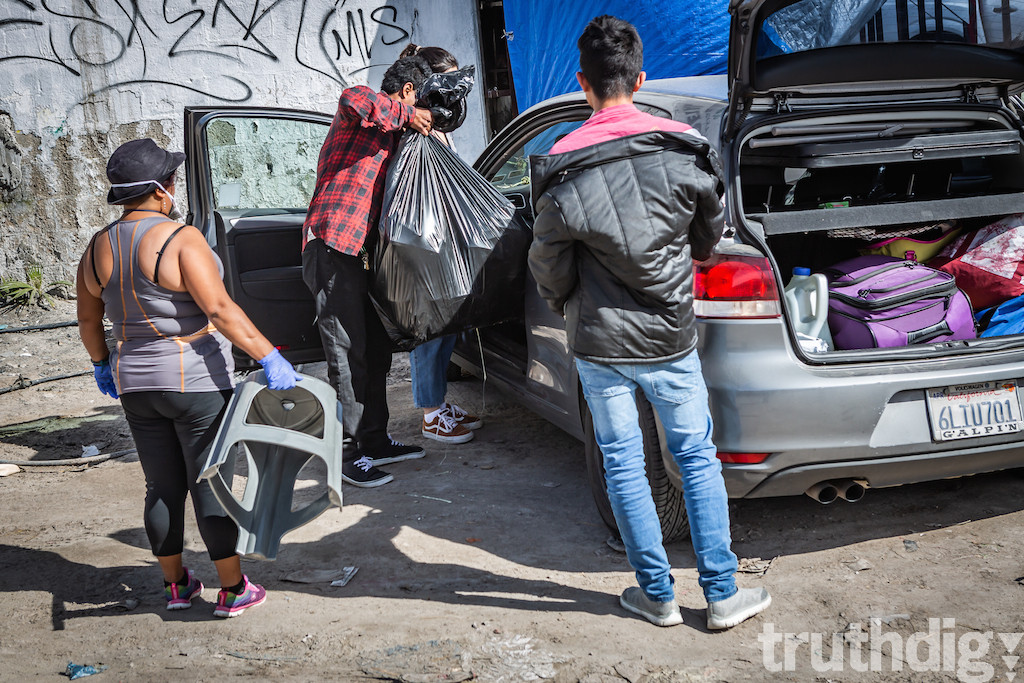
Coda
Just like the issues of poverty and perpetual war, the so-called immigration crisis is a human creation. It’s not a national emergency. It’s a human disgrace.
Unless we begin to address the causes of mass migration and displacement—widening economic inequality, climate change, the rise of nationalistic fervor, potential resource wars in Latin America, to list a few—these fragments I have described, these misshapen puzzle pieces of what is happening at the U.S.-Mexico border, will be just the beginning.
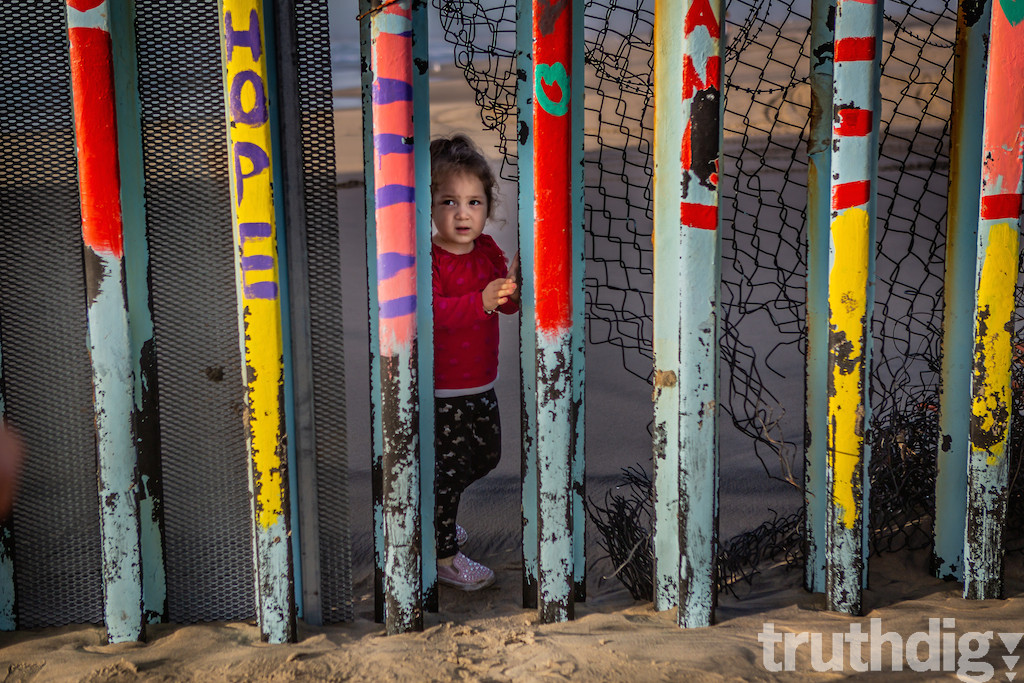
Independent journalism is under threat and overshadowed by heavily funded mainstream media.
You can help level the playing field. Become a member.
Your tax-deductible contribution keeps us digging beneath the headlines to give you thought-provoking, investigative reporting and analysis that unearths what's really happening- without compromise.
Give today to support our courageous, independent journalists.

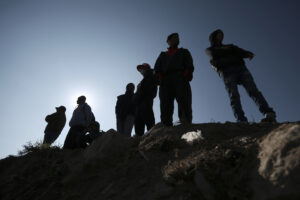
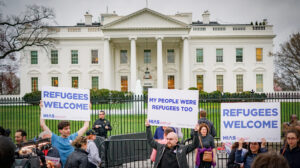
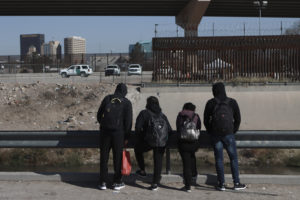
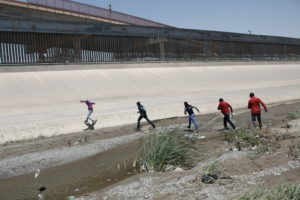
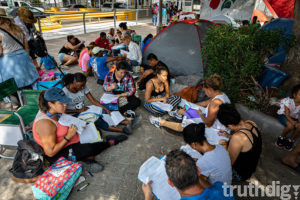
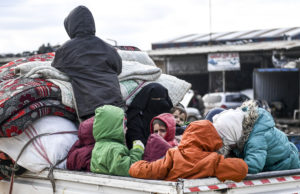


You need to be a supporter to comment.
There are currently no responses to this article.
Be the first to respond.